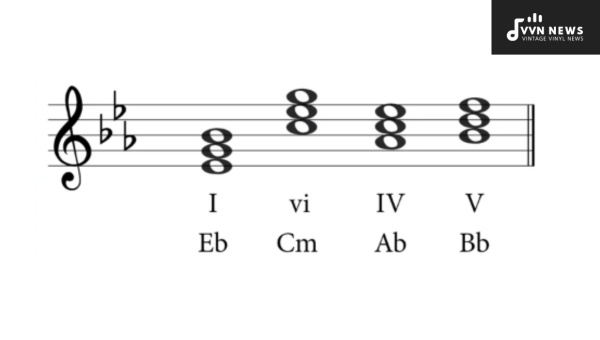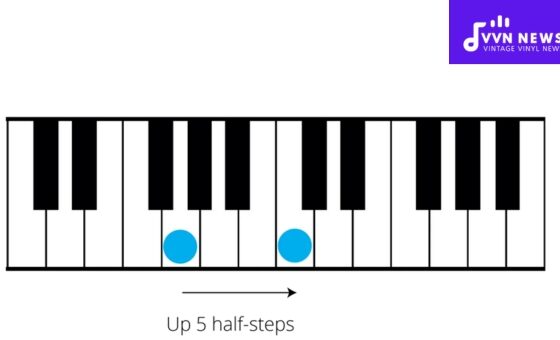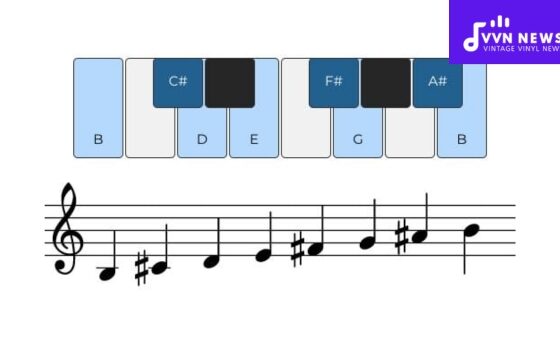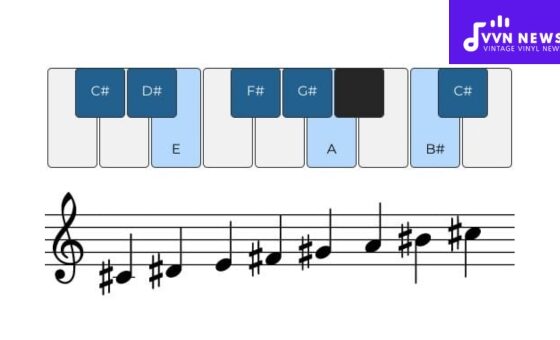Chords in music play a crucial role in creating harmony and depth. Whether you are an aspiring musician, a music enthusiast, or a seasoned performer, understanding chords is essential to enhance your musical skills.
In this article titled Chords In E Flat Major: A Music Theory Guide, we will explore the fundamentals of chords and take a closer look at the chords in the key of E Flat Major.
So, grab your guitar or sit down at the piano as we embark on an informative journey into the world of E flat major chords.
Understanding different chords and their relationships is like unraveling a musical puzzle. By delving into the theory behind music, we can unlock endless possibilities for creative expression.
We will focus on the key of E flat major – a popular key in various genres such as jazz, soul, and pop.
Whether you are already familiar with this key or just starting out, this article will provide valuable insights into creating beautiful harmonies using Chords In E Flat Major: A Music Theory Guide techniques.
So, let’s dive right in and uncover the enchanting possibilities that lie within E flat major chords.
The Primary Chords in E Flat Major
When exploring the chords in the key of E flat major, we encounter three primary chords. These chords are built on the first, fourth, and fifth degrees of the E flat major scale. Let’s take a closer look at each of them:
- I chord: The tonic chord, also known as the “home” or “main” chord, is formed by taking the first note (root) of the scale (E flat), the third note (G), and the fifth note (B flat). In E flat major, this results in an E flat major chord (Eb).
- IV chord: The subdominant chord is built on the fourth degree of the scale (A flat). It comprises A flat, C, and E flat notes. In E flat major, this gives us an A flat major chord (Ab).
- V chord: The dominant chord is formed by taking the fifth note of the scale (B flat) and constructing a major triad using B flat, D, and F notes. In E flat major, this results in a B flat major chord (Bb).
These primary chords serve as a foundation for creating harmonic progressions and building melodies within the key of E flat major. Understanding these three chords is crucial for any musician looking to explore this captivating key further.
How do Seventh Chords Improve E Flat Major Harmony?

Seventh chords add depth and complexity to the harmony in the key of E flat major. They consist of four notes: the root, third, fifth, and seventh. These additional notes introduce tension and create a richer sound. Let’s explore how seventh chords enhance the harmony in E flat major:
- Dominant 7th Chord: The dominant 7th chord is formed by adding a minor seventh interval to the dominant chord (the V chord). In E flat major, this results in a B flat dominant 7th chord (Bb7). The dominant 7th chord has a strong pull towards the tonic chord (I), creating tension and leading to resolution.
- Major 7th Chord: The major 7th chord is created by adding a major seventh interval to the root chord (I). In E flat major, this gives us an E flat major 7th chord (Ebmaj7). The major 7th chord has a smooth and lush sound that adds elegance and sophistication to your music.
- Minor 7th Chord: By adding a minor seventh interval to the subdominant chord (IV), we form a minor 7th chord. In E flat major, this results in an A flat minor 7th chord (Abmin7). The minor 7th chord adds a sense of melancholy and can be used to create emotional depth in your compositions.
- Half-Diminished or Minor Seventh Flat Five Chord: This unique-sounding chord is built by adding a diminished fifth interval and a minor seventh interval to the vii degree of the scale (B diminished). In E flat major, this gives us a B diminished/minor seventh (Bø or B-7b5) chord. This versatile chord can add tension and ambiguity to your harmonies.
Using seventh chords in your E flat major compositions and arrangements can open up a world of creative possibilities.
They bring richness, tension, and sophistication to your music, allowing you to create captivating melodies and harmonies.
Experiment with these different types of seventh chords to add depth and complexity to your E flat major compositions.
Also Read: E Flat Major Blues Scale [Enhance Your Musical Expression]
Intriguing Chord Progressions in E Flat Major
Chord progressions are like the building blocks of music. They create the emotional journey and narrative of a song.
In the key of E flat major, several chord progressions can captivate listeners and add depth to your compositions. Let’s explore a few intriguing chord progressions in E flat major:
1. I – IV – V Progression
The I-IV-V progression is one of the most common and versatile progressions in music. In E flat major, this progression would be Eb – Ab – Bb.
It creates a sense of stability and resolution, making it an excellent choice for choruses or when you want to emphasize a powerful, triumphant sound.
2. ii – V – I Progression
The ii-V-I progression is commonly found in jazz and fusion genres, adding complexity and color to your compositions. In E flat major, this progression would be Fm7 – Bb7 – Eb.
The ii chord (Fm7) adds tension before resolving to the dominant V chord (Bb7), which then resolves to the I chord (Eb), creating a satisfying resolution.
3. vi – IV – I – V Progression
This progression has been used in countless pop songs and ballads, evoking feelings of nostalgia and sentimentality. In E flat major, this progression would be Cm7 – Ab – Eb – Bb.
The vi chord (Cm7) sets a melancholic tone before moving to the IV chord (Ab). The I chord (Eb) reinforces stability before resolving to the powerful V chord (Bb).
4. Secondary Dominant Progression
Adding secondary dominants can inject excitement and unpredictability into your musical composition.
In E flat major, you can introduce secondary dominant chords by raising the fifth note of the desired chord by a half step and creating a dominant seventh chord.
You can use C7 as a secondary dominant leading to the IV chord (Ab). This creates a tension-release effect that adds intrigue to your music.
Also Read: E Flat Major Scale [Master This Essential Musical Tool]
How does ear training enhance your comprehension of E Flat Major chords?

Ear training is a vital skill for musicians of all levels, helping to develop a deeper understanding and recognition of musical elements.
When it comes to comprehending E flat major chords, ear training plays a significant role in sharpening our musical perception.
Here are some ways in which ear training can enhance your understanding and mastery of E flat major chords:
1. Recognizing chord qualities:
Ear training allows you to identify the unique sound characteristics of different chord qualities in E flat major, such as major, minor, augmented, and diminished chords.
With practice, you’ll gain the ability to distinguish between these chord types solely by listening.
2. Grasping chord progressions:
By training your ears, you can discern the common chord progressions found in E flat major. This includes recognizing the movement from the I (E flat) chord to the IV (A flat) or V (B flat) chord. This skill is invaluable when playing or composing music in this key.
3. Transcribing by ear:
Ear training enables you to transcribe songs and melodies by listening attentively to their chord progressions and identifying the individual chords used. This refined skill opens up a world of possibilities for learning new songs without relying on sheet music.
4. Improvisation skills:
Developing your ear allows you to spontaneously create fitting melodies and harmonies over E flat major chords while improvising. You’ll become more attuned to the sound characteristics of each note within these chords, guiding your improvisational choices.
5. Aural analysis:
With consistent ear training, you’ll be able to mentally analyze any piece of music in E flat major without needing an instrument or sheet music. This skill strengthens your overall musical understanding and empowers you to interpret and appreciate compositions more deeply.
To improve your ear training specifically for E flat major chords, you can practice activities like chord recognition exercises, transcribing songs in this key, and singing or playing scales and arpeggios associated with E flat major.
Incorporating ear training into your regular music practice will undoubtedly enhance your comprehension and proficiency in working with E flat major chords.
Piano Chord Variations in E Flat Major
If you’re a pianist looking to add some variety and flair to your music in the key of E flat major, exploring piano chord variations is a great way to achieve that. Here are some chord variations you can incorporate into your playing:
- Extended Chords: One way to add complexity and richness to your chords is by incorporating extensions. These include adding extra notes beyond the basic triad. In E flat major, you can experiment with extended chords such as the major 7th (E♭maj7), dominant 7th (B♭7), minor 7th (Cm7), or even the minor-major 7th (Dø(maj7)).
- Inversions: Inversions allow you to rearrange the notes of a chord while maintaining its harmonic function. Try playing chords in their root position, first inversion (with the third in the bass), and second inversion (with the fifth in the bass). This will create interesting melodic movements and smooth transitions between chords.
- Chord Substitutions: Another way to spice up your piano playing in E flat major is through chord substitutions. Replace a basic chord with another that has similar harmonic qualities. For example, consider using a tritone substitution, where you substitute the V chord with a dominant 7th chord rooted a tritone away (e.g., substitute B♭7 with E7).
- Passing Chords: Incorporating passing chords can add color and interest to your progressions. These transient chords are placed between two stable chords to create smooth transitions or tension-release moments.
- Voicings: Experimenting with different ways of voicing your chords on the piano allows for individual expression and unique sounds. Try using open voicings, closed voicings, or even spreading out the notes across multiple octaves to create a fuller sound.
By exploring these piano chord variations in E flat major, you can unleash a world of creative possibilities and elevate your playing to new heights.
Don’t be afraid to experiment and find the combinations that resonate with you and your musical style.
Also Read: E Flat Music Note [Master The Symbols Of Musical Notation]
Achieving a Distinctive Sound with E Flat Major Chords on the Guitar

As a guitarist, you have the power to create a distinctive sound with E flat major chords. Here are some techniques and considerations to help you achieve that:
- Chord Voicings: Experiment with different chord voicings to add depth and richness to your sound. Try using barre chords or open chords in different positions on the guitar neck. This will give you a variety of tonal options when playing E flat major chords.
- Strumming Patterns: Vary your strumming patterns to create rhythmic interest and dynamic variation. Experiment with strumming techniques such as fingerpicking, palm muting, or using a pick to change the sound of your E flat major chords.
- Extended Chords: Expand your chord vocabulary by incorporating extended chords into your E flat major progressions. Add maj7, dom7, or sus4 variations to your basic chords for added color and complexity.
- Modulation: Explore modulation techniques by transitioning from E flat major to related keys such as C minor or G minor. This adds an interesting twist and can create unique musical moments in your compositions.
- Effects Pedals: Utilize effects pedals such as reverb, delay, or distortion further to enhance the sound of your E flat major chords. Experiment with different settings and combinations to find the perfect tone that suits your musical style.
Achieving a distinctive sound is not just about the technical aspects but also about infusing your own creativity and personal touch into your playing.
Explore different styles, genres, and influences to develop a unique voice as a guitarist using E flat major chords.
Chord Inversions: Enhancing E Flat Major Music
Chord inversions are alternate voicings of a chord where the root note is no longer the lowest-sounding tone. Instead, another note from the chord becomes the bass note.
This technique can bring new colors and unique sounds to your music, adding depth and interest to your compositions in E flat major. Let’s explore chord inversions further:
Chord Inversions
In traditional music notation, chords are notated with the root as the bass note.
Chord inversions change this by rearranging the order of the notes within a chord. The result is a new harmonic texture that creates a sense of movement and rhythmic interest.
Benefits of Chord Inversions in E Flat Major
- Creating Smooth Voice Leading: Chord inversions can facilitate smoother transitions between chords by minimizing large leaps between notes. This technique makes your progressions sound more fluid and melodic.
- Expanding Range and Expressivity: By using different inversion possibilities, you can extend the range of your chords beyond their typical positions, adding complexity and emotional depth to your compositions.
- Enhancing Melodic Lines: Inversions allow you to create interesting melodies within your chord progressions by highlighting different notes in each inversion. This can add intricate layers to your music’s overall sound.
Also Read: D Sharp Minor Blues Scale [Master The Moods Of Music Theory]
How to Use Chord Inversions in E Flat Major
- Identify Key Chords for Inversion: Begin by understanding which chords you want to invert within E flat major—for example, I (Eb), IV (Ab), or V (Bb).
- Determine Available Inversions: Experiment with various chord voicings by rearranging the notes while keeping their original pitch class intact. Consult theory resources or use online tools for common inversion patterns.
- Consider Bass Note Options: Choose a different bass note within each inversion that still complements the harmony of the chord. This provides a foundation for the chord and affects its overall impact.
- Experiment and Refine: Explore different combinations of inversions in your progressions to find ones that sound pleasant to you. Trust your ear and musical instincts as you play around with the possibilities.
By incorporating chord inversions into your compositions, you can elevate and enhance your music in the key of E flat major.
These alternate voicings provide depth, richness, and a fresh perspective on familiar chord progressions, making your music more captivating to both yourself and your audience.
FAQ About E Flat Major Chords
What are the different types of seventh chords that can be used to enhance the harmony in E flat major?
In E flat major, you can use major seventh, dominant seventh, and minor seventh chords to add complexity and richness to your harmonies.
Can E flat major chord progressions be used in genres other than jazz and pop?
Absolutely! While E flat major is commonly employed in jazz and pop music, it can also be used effectively in various other genres such as soul, R&B, and gospel.
How does ear training improve my understanding of E flat major chords?
Ear training allows you to develop a keen sense of hearing different chord progressions and intervals within the key of E flat major, enabling you to better recognize and reproduce them.
What are some piano chord variations I can try within the key of E flat major?
Some common piano chord variations in E flat major include adding extensions (such as ninth or thirteenth) or altering certain notes within the chords for a more unique sound.
How can guitarists achieve a distinctive sound with E flat major chords?
Guitarists can experiment with different inversions, voicings, and techniques such as arpeggios or fingerpicking, to create their own signature sound when playing E flat major chords.
Conclusion
Mastering the chords in E flat major opens up a world of musical possibilities. By understanding the primary chords I, IV, and V, you can create solid foundations for your compositions and improvisations. Experimenting with seventh chords adds extra richness and complexity to your harmonies.
Exploring intriguing chord progressions and variations on piano or guitar allows for artistic expression and unique soundscapes. Don’t forget the importance of ear training to sharpen your perception and grasp chord relationships more intuitively.
So grab your instrument and let the enchantment of E flat major’s chords guide you on a musical journey of creativity and expression.








